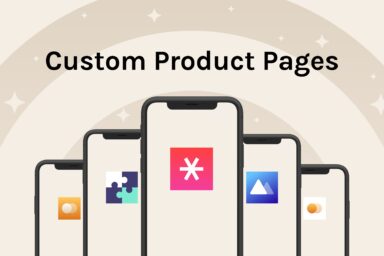iOS 15 new features and update – what is new in Apple App Store?
iOS 15 brings along some major changes for App Store Optimization (ASO), User Acquisition, and app marketers around the world.
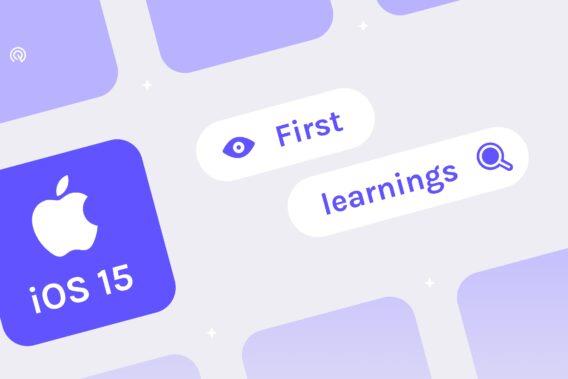
In-app events were fully launched on the 27th of October 2021. On the 8th of December 2021, Custom Product Pages and Product Page Optimization finally went live too. Although app marketers are excited about the new iOS 15 features, it is still unclear for some marketers how to use these features. So, let’s have a deeper view of what we learned so far about the new iOS 15 features.
Everything you need to know about in-app events
As the first out of the three iOS 15 new features, in-app events went live at the end of October 2021. As timely events (up to 31 days) within apps and games, they provide a great way to engage with current users, reach new users, or reconnect with previous users. We can highlight that the adoption rate of in-app events across the app marketing industry is high so far! Many app marketers see this new iOS 15 feature as a great fit for games, but in-app events are being successfully used by many other app categories as well.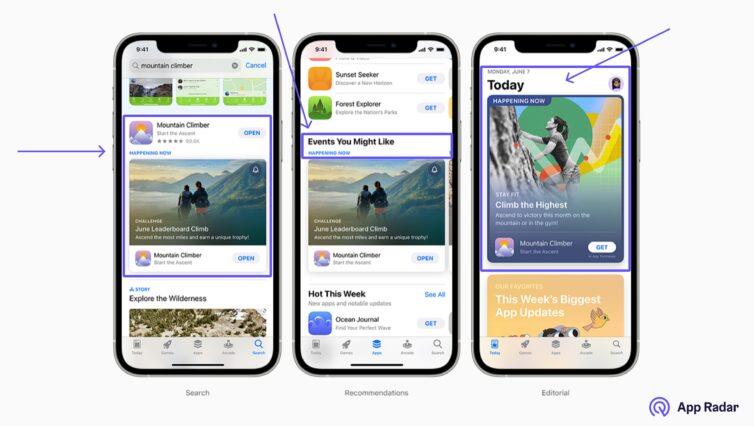
We can also assume that the fear of missing out and losing potential discoverability over to competitors will drive the adoption rate even more. Hence we expect that including in-app events will soon become the standard of what a store listing page looks like.
IAE analytics now available in App Store Connect
On the 6th of January 2022, Apple finally made analytics for in-app events available in App Store Connect. No more wild guessing about the performance! You can now check event page views, reminder and notification data. Moreover, you can also see the number of downloads and redownloads that were coming from your in-app event. Each metric can be filtered by local, source type, device, and more.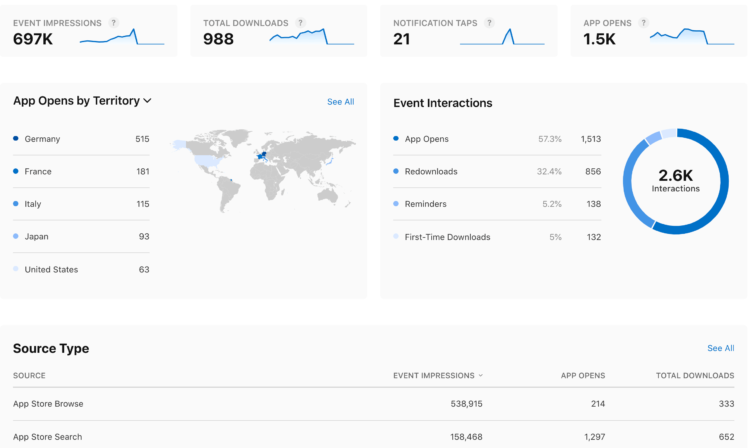
Get featured with your in-app events
In-app events impact mobile app growth across all traffic sources. Besides the store listing page, in-app events also appear in search results as well as in featured placements. Moreover, there is a dedicated section reserved for in-app event featuring. 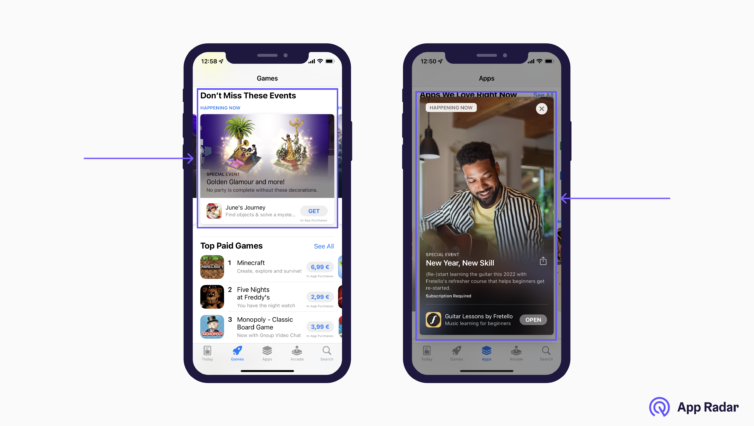
Wondering how you can get your IAEs featured? You can apply for a featuring through this form. Thereby you’ll be able to increase the likelihood of getting featured.
In-app events metadata are indexed
Another good news is that keywords included in the event name and short description are being indexed! This means you’ll have higher chances to rank for those keywords in the app store search results. So make sure to include relevant keywords that you want to rank for within your in-app event name and a short description!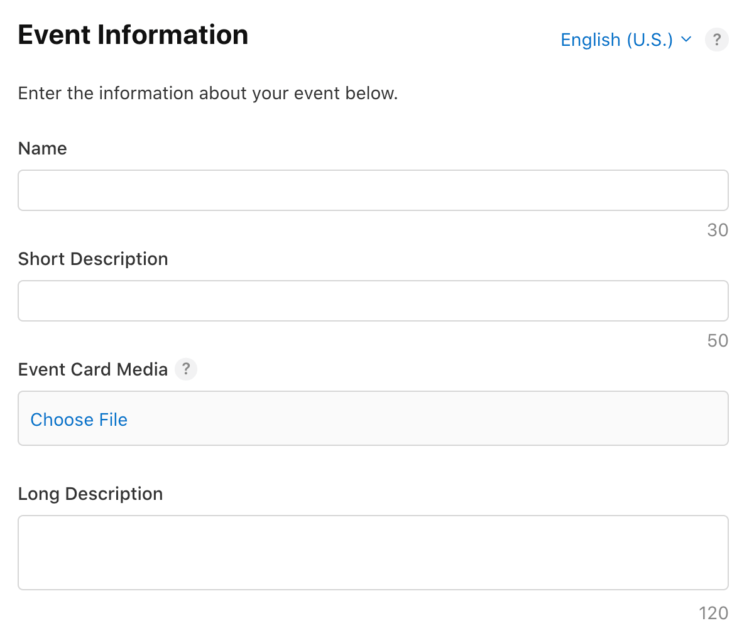
Learn how to use Apple In-App Events (IAEs) to increase your organic visibility.
Another important thing to consider is the possibility of submitting multiple elements. For example, now you can submit in-app events and product page tests for review at the same time. However, while those entities are waiting for review, you cannot submit more assets. Moreover, you also cannot submit a new app version until the App Store Review team completes the reviewing process. So make sure to plan ahead especially for time-sensitive elements.
Everything you need to know about Custom Product Pages
Customization is revolutionizing the way we do app business. It’s no longer about one size that fits it all. Great marketing campaigns are those which are tailored to target specific groups of people throughout the whole customer journey. Now for the first time ever on the Apple App Store, custom product pages (CPPs) enable app marketers to create different product pages for specific audiences. Moreover, it is also possible to share them through unique URLs. You can use those URLs everywhere you use links, to drive traffic to your landing page. That could be an email marketing campaign or paid UA campaign.
We can definitely highlight that it is a powerful feature to improve conversion rates, cost-per-install, and ROAS.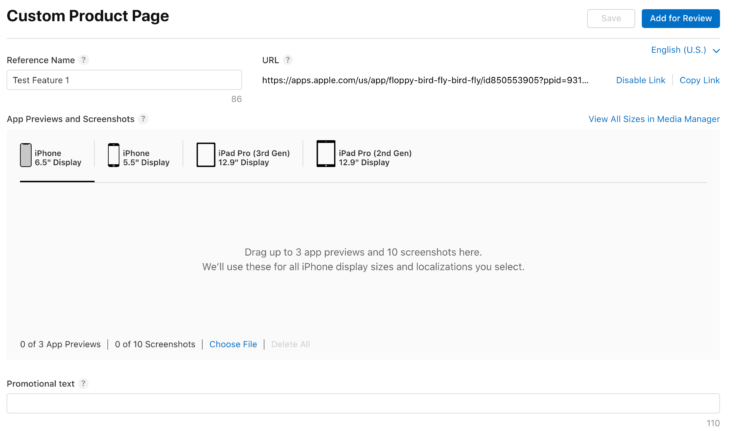
Ad networks can use custom product pages through StoreKit-rendered ads
Custom Product Pages are creating a lot of buzz in the app marketing world. When creating a CPP, a unique URL will be generated that you can use for your campaigns. However, the problem here is that many ad networks don’t support these unique URLs in the campaign setup. The solution for it is supposed to be “StoreKit-Rendered ads” which are supported by most of the ad networks. That’s big news for app marketers!
It is important to know that StoreKit-rendered ads display the full store listing page as an impression. It allows users to install the advertised app directly from the ad instead of sending them again to the full app store product page.
In other words, StoreKit-Rendered ads support the setting up of campaigns by using CPPs as the destination, not the default App Store listing page.
Advertising networks can also use custom product pages in StoreKit-rendered advertisements. They’ll use the custom product page ID as the customProductPageIdentifier when using SKOverlay, or as the SKStoreProductParameterCustomProductPageIdentifier when using SKStoreProductViewController.– Apple App Store Developer
As the industry adopts, we can assume more and more ad networks starting to support custom product pages. As a result, app marketers will be able to use CPPs in probably all ad networks by specifying a unique CPP identifier in the campaign setup. Amazing, isn’t it?
IronSource is the first ad network to support Custom Product Pages
We are glad to highlight that IronSource is the first ad network that enables you to include CPPs in your ads. For app marketers, this means that they can now connect creatives to unique product pages. Thereby providing users with a customized App Store experience to boost conversion rates.
Apple Search Ads support Custom Product Pages
Starting from early 2022, CPPs are supported within their Apple Search Ads. Now you are able to select custom product pages from your Apple Search Ads account. It enables you to create variants of your store listing page that are most relevant for different keyword groups.
Important to highlight that as a part of the transition, Creative Sets were removed from Apple Search Ads. This means that now advertisements with Creative Sets have stopped running. During the transition time, your default ad was supposed to run instead. As integration is rolled out, Customer product pages are supposed to build a powerful replacement.
Custom Product Pages might appear in featured placements
It is also worth stressing that the search results won’t be impacted by custom product pages. Moreover, they won’t appear when someone searches for your app or game in the Apple App Store. However, they might appear in featured placement like the Today, Games, and Apps Tabs. Thus CPPs will have a small impact on your Browse traffic.
Everything you need to know about Product Page Optimization
On the 8th of December 2021, the day finally arrived when this long-waited iOS 15 new feature went live. But what does it mean for app marketers? Product page optimization (PPO) enables you to run native A/B tests on your default App Store Page. As more and more traffic will be handled through CPPs, it will become an essential part of organic conversion rate optimization. However, keep in mind that so far PPO still has some limitations.
Note: If you are using custom product pages and drive all your paid UA traffic to those app store pages, PPO will receive only organic traffic from search and browse. So to sum up, PPO enables you to purely A/B test your organic product page.
A/B tests are shown only to iOS 15 users (or later)
It is important to know that product page optimization A/B tests are shown only to iOS 15 users or later. So, more sample traffic will be available as the adoption rate continues to grow. This means you should get results faster, once more people upgrade to iOS 15.
Test screenshots and app previews without a new app version
The new product page optimization feature enables you to test screenshots and app previews within up to 3 different versions. Moreover, you don’t need to have a new app version in order to start testing. If you want to test new creatives as your treatments, then you will need to submit them for review. The latest live app version will be used when reviewing your submitted creatives. This means your app’s status must be “ready for sale”. According to Apple, it can take up to 24 hours until your creatives get accepted. From our experience, reviews have been most of the time approved within a couple of hours.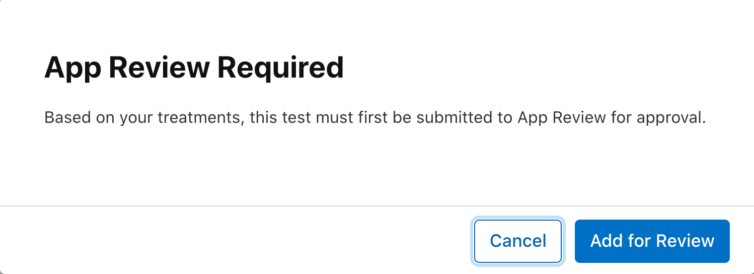
If you only want to test with the current set of screenshots and don’t upload any new screenshots, you can start the test immediately. This means no review is needed anymore as they have already been approved before by Apple. This is a great opportunity to test, for example, the order of your screenshots!
Note: Product page tests will be automatically stopped if you submit a new app version.
Test the app store icon aesthetic
Whereas in contrast, for testing app icons aesthetic, you’ll have to submit a new app version with the icons you want to test in the binary of the app. The reason behind this is that Apple wants to ensure that users who downloaded your app with a certain icon will also see the same icon on their home screen.
In case the winning version is not your current variant and you want to roll it out to all users, you’ll have to include that new icon in the next app submission version.
Note: You need to have Xcode 13 or a later version to be able to add multiple icons in the binary.
Traffic allocation for product page optimization
Another great highlight of product page optimization is that you can choose the amount of traffic that you would like to drive to your tests. In other words, you choose the percentage of users who will be randomly shown a test treatment instead of your original product page.
For example, if you decide to go with a 75% split, then 25% will continue to see your original store listing page. The other 75% will be split for each treatment that you want to test. Let’s say you have three treatments that you want to test, then each of them will get 25% of your overall traffic.
Note: If you’re using custom store pages for all your paid traffic, your default App Store product page will only get organic traffic, composed of search and browse traffic.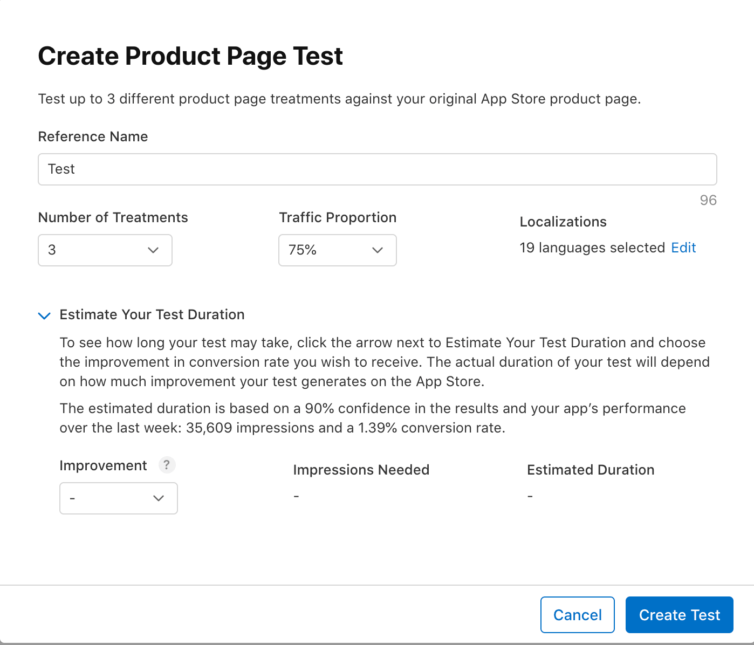
Test duration estimation
App Store Connect gives you an estimation of how long the test will take in order to achieve a certain improvement selected by you. This calculation is based on existing performance data of your app, such as daily impressions. It is intended to help you with an estimation, but will not affect your testing results. Instead, it will show you the number of impressions that you’ll need to reach for at least 90% of confidence.
Therefore, the duration of the test will highly depend on the traffic you’re getting. Hence apps with a lot of daily traffic will receive results faster. But always keep in mind to leave your test running for at least 7 days to avoid seasonal spikes. Depending on the category, the conversion rates might be much higher on weekends than during the week. In this case, testing for less than a full week would heavily skew the results.
The maximum duration of a test is 90 days. This means after 90 days tests will be automatically closed, no matter if you reached the confidence level or not.
Localized testing not yet fully rolled out
As you might already know, app marketers have to connect with consumers on their playing fields. And that means understanding users’ languages, cultures, and traditions. We can’t stress it more, proper localization is key to success in app marketing! This applies also to your product page tests. For each test, you can choose a specific localization. In other words, it gives you the opportunity to test different audiences.
Learn more about how to Localize Your App and Reach a Global Audience.
While localizing your test, please pay attention to one important point. If you go with the default settings and choose all localizations, then all users will see the localized version you are testing. For example, if you want to test French screenshots, but you didn’t choose French as localization, then your test will be shown to all users, even those who don’t speak French. So make sure to always choose the specific localization that you want to test!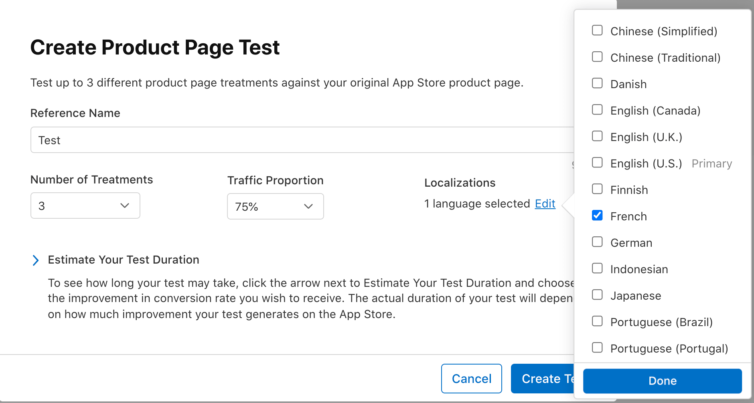
Also, keep in mind that at the moment you can only set up one test at a time, and you can’t filter analytics by locals. So, the only way to do proper localized testing is to separate tests for separate locals. As the feature is still in its early stages, we’d expect this to still be adapted. So hopefully soon, you can run more localized tests at the same time.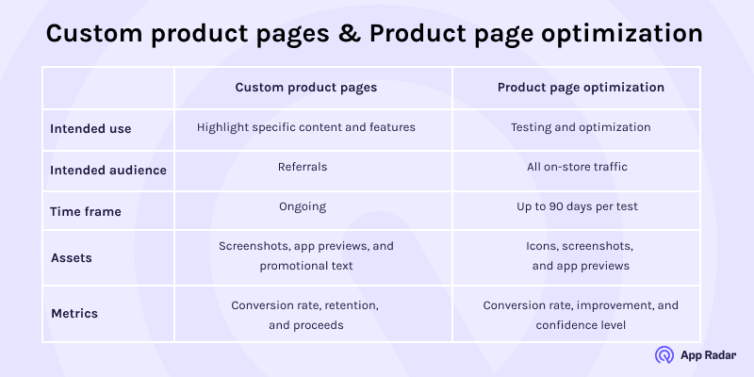
Learn more about Product Page Optimization and Customer Product Pages.
Summary of first learning of iOS 15 new features
The iOS 15 new features are revolutionizing the way app marketers are doing business. In-app events are expected to become the standard of any app store listing. It will help to increase engagement with current users, attract new and re-engage inactive app users. Custom product pages enable customized messaging for paid UA campaigns. Moreover, it has the potential to drastically improve paid growth rates, ROAS, and cost per install. Product page optimization lets you define the best performing screenshots, preview video or app store icon aesthetic. In other words, it helps to improve organic conversion rates.

Latest Posts
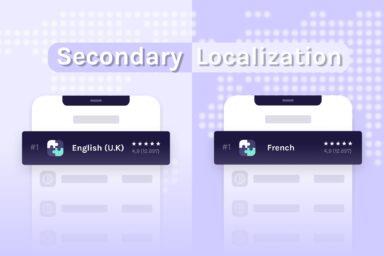
iOS App Product Page Localization: How to Use it the Right Way to Improve ASO
Top 10 Most Downloaded Games in Google Play Store (July 2025 Update)
Google Play Store Listing Experiments: How to Run Native A/B testing for Android Apps for Free!
12 Best Mobile Measurement Partners (MMPs) to Consider for Your Mobile App Attribution in 2025
Related Posts
